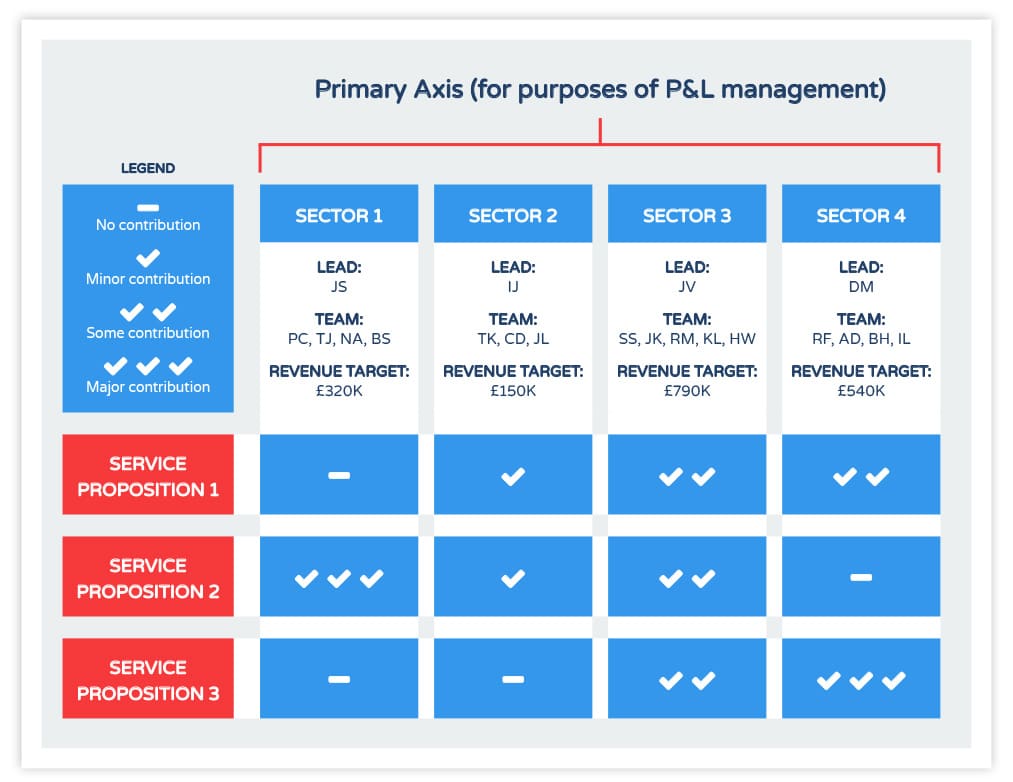Hungry happenstance in early years - a key question - leading to a potent, growth-enabling one-pager - Choose your primary axis with care - Unsure, then step into your clients’ shoes - Next stop, sector plans
We have come a long way on the journey as to how the best professional service companies sell their services (see starting blog here). Before moving on from this thread, however, I want to talk about a couple of final critical aspects; starting with a deliberate consideration as to how you go to market.
Of course, determining how to take your professional services to market should be an essential component of your earliest business thoughts. In its broadest sense, a go to market strategy is a description of how you reach your customers: in terms of how you package your proposition(s), how you price, your segment targets, analysis of key decision makers and purchasers, how you market and sell, how you deliver your services, whether you collaborate with others in this process etc.
Specifically, however, I want to look at the sub-question of how you best go to market from the perspective of building your selling capabilities (and related internal organization, structures and systems).
Before I dive into this, let me paint the common early-stage progression for a professional service company. Even if you are an established business – bear with me – the critical review will be worth it.
Typically, the first months and years (perhaps with only a singleton or small team of founders) is about commercial survival. Invariably, most such companies are confident and clear with respect to their technical capabilities and related service proposition(s). Most are aware that the more tightly delineated this technical expertise/offering is, the more salient a go to market message you can deliver cf. an “all things to all people” generalist. Similarly, your geographic playing field tends to be a function of happenstance; most companies will set up initially to deliver close to where they are based. In the thoughts of founders, geographic expansion beyond the familiar local can happen down the line.
Typically, also, most early stage professional service firms – albeit not all – are somewhat opportunistic when it comes to any sector focus (i.e. a market/industry sector in to which they message valid expertise/experience networks etc). That is, even if such early sectors are pronounced on a website, the reality is work will be hungrily accepted from whether it comes. This can lead to a situation whereby actual early client relationships are forged as a function of happenstance as opposed to any deliberate go to market planning.
As such, a very common maturation step (even within some very established businesses) is to go through a very deliberate sector development exercise.
I have worked with a number of companies now – as a reinforcement of my own experience – where one of the most powerful growth inflection points has revolved around answering this question: how do we best go to market with respect to our sector focus and development?
Developing a go to market one-pager
One of the simplest and most potent growth tools I have seen has been the one-pager (see illustration below) result of such conversations: a simple table illustrating how the companies headline revenue target will be attacked via sector based sub-targets. Such a schematic details single-point accountability (i.e. the sector lead accountable for this target) and the team supporting. Over recent years, I have been a privileged board member of a (very capable) company using this simple tool to regularly track their progress from a c. £4m/annum business to c. £15m/annum now.
Initially, their one-pager had a number of gaps and/or individuals covering multiple columns/sectors but – with regular gatherings around this central device – they hired experts into gaps, divided up previously merged clustered sectors into increasingly focused areas and systematically grew out their sector teams (and revenue goals). Put another way, a sector-based go to market structure became the primary axis on which they planned for revenue/company growth and the primary basis on which they internally organised themselves with respect to selling/delivering services and ongoing staff development.

Example Go to Market Organizational Schematic
I should make an important organizational point here. What I have just described is the classic maturation phase from organic start-up into a more structured operation. In such maturer stages, it is very common to see such a matrix structure: with professionals residing into two or more organisational homes (e.g. organised by service specialisation and industry sector). In this context, there is always a choice as to the primary dimension you choose to go to market – recognising that you can actually go to market via multiple dimensions (e.g. by service specialism, sector focus, geography etc.). My point here is that leaders need to carefully, first, choose the primary dimension – as this facilitates organizational clarity with respect to business development and internal (recruitment) growth targets. The converse – multiple heads working to grouped targets – often leads to a lack of focus, managerial obfuscation and sub-par delivery results. With that said, you should understand that sector development needn’t be the primary dimension you organize to! It just happens to be the one I focus on here as it is the most common; the reasoning for this is that it often talks to what clients value most, over and above technical expertise: that you intimately understand their unique industry-specific challenge.
If you decide not to use sectors as your primary organizing construct, just ensure you choose the dimension most important to the market you serve. If you are unsure as to what this is, I implore you to take the time to ask current and prospective clients this very question (they will respect you for doing so).
So, as you leave the foothills of early-year hunting, and as soon as a team starts to build, I strongly encourage you to sit down and develop an aspirational go to market plan. If you choose sector-development as this primary axis, maybe allocate initial leads to a first proposed set and assign supporting junior colleagues to one or two sectors as aligned to their professional interests/backgrounds. Cast forward how such a structure should look in future years as a basis for your revenue and team growth.
In a related fashion, you will want to encourage any newly-formed sector teams to develop sector-level sales plans – preceded by appropriate analysis; for example, what is the sub-segmentation within the sector, who are the key players, what are the strategic issues being faced. Such sector plans will typically cover four key areas:
- Business Development (hunting and farming).
- Collateral Development (e.g. thought leadership, sales support materials).
- Market Intelligence (ongoing analysis and opportunity identification).
- Team Up-skilling (sector-specific CPD and knowledge sharing).
Within the Business Development section of a sector plan, you would want to see a breakdown of the different forms of sector-level sales activities including:
- Sector-specific campaigns (e.g. a seminar series based on a focused piece of research).
- Targeted Priority Accounts (some may each warrant an Account Management Pack?)
- Ongoing generic sales activity targets (e.g. call, meeting targets etc).
With such sector plans in place, sector teams should then start to meet regularly (say, weekly) to review progress to plan at an activity level and as per key metrics set (e.g. calls held, meetings booked, meetings held, revenue booked etc).
Of course, none of this happens overnight but what I have described here is how many successful professional service firms intelligently evolve from early entrepreneurial fluidity towards established sales and delivery capabilities.
So, regardless of whether your early team is entering into this phase – or – you are an established business seeking a simple growth paradigm, do yourself a huge service: spend some time planning out your go to market strategy.
It could be one of the most important one-pagers you ever generate!
So, what’s next?
Next week, I will conclude my focus on selling and how to build a sales capability with a look at writing winning proposals.
Hopefully, you’ll join us on this journey. It’s totally free, and you don’t have to be a Method Grid customer (though you’re more than welcome to sign up for a free trial here).
We’ll be releasing a new post each week. To get each post emailed to you as soon as it’s published, sign up for the Climbing Mount Audacity mailing list below.
Climbing Mount Audacity…
From Startup to Scaleup!
We're sharing everything we know about how to build an awesome professional service firm (and enjoy the journey en route!) PLUS travel updates, reflections on our stumbles and general musings on our Method Grid journey.
Signup below to get the latest articles
direct to your inbox.
See you next week. Have something you want to hear more about? Let me know in the comments below or via Twitter.

 Project and Program Management
Project and Program Management  Project Governance Framework
Project Governance Framework  Benefits Management Framework
Benefits Management Framework 







I’m just getting a new business off the ground and exactly in this ‘sales’ phase – your email arrived at the right time!
All the best with the new business!
Great to hear Andy. All the very best with the new venture.